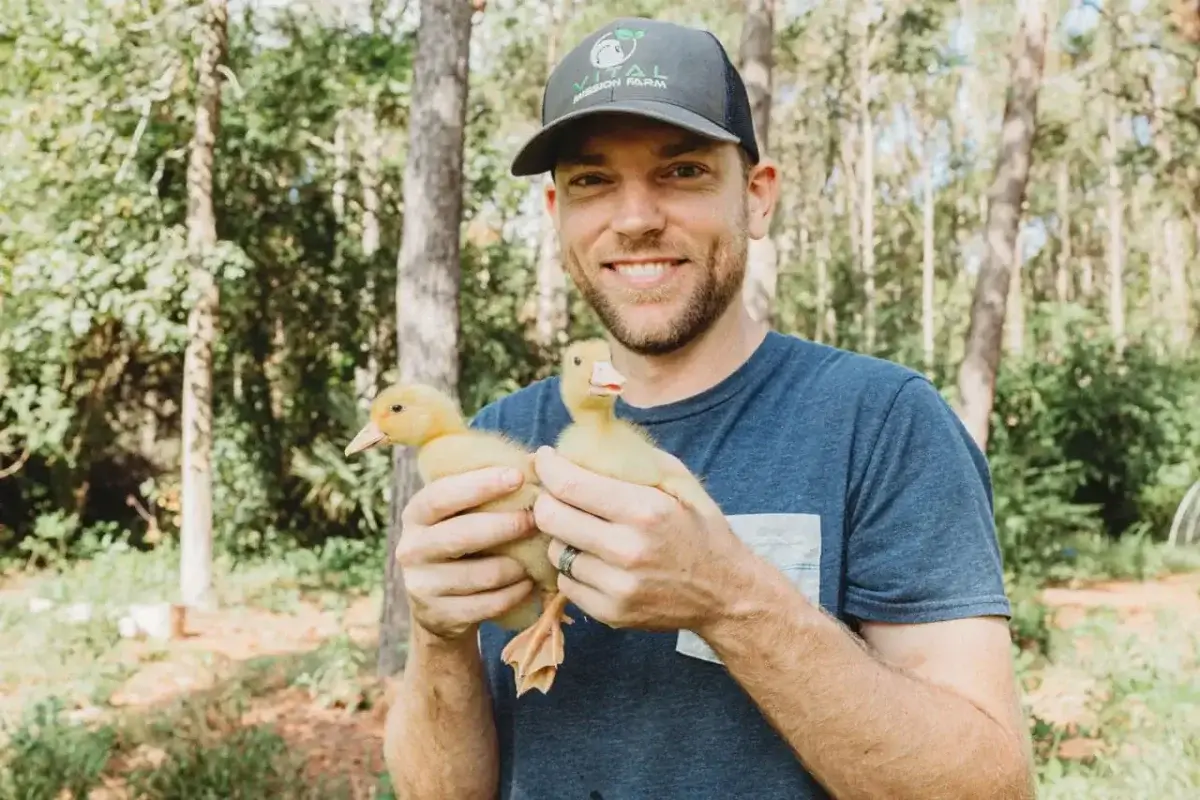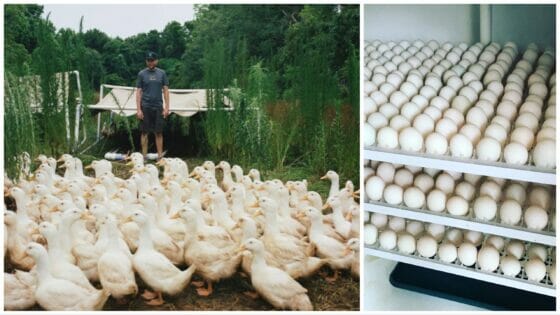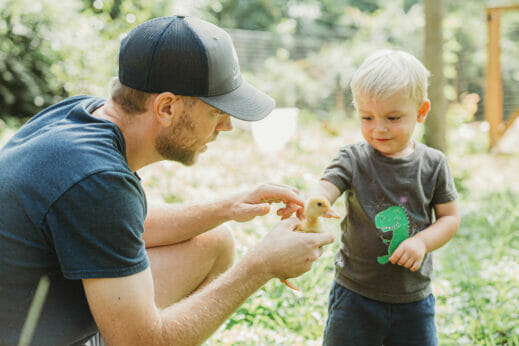Meet the Poultry Farmer Teaching Others How to Make Regenerative Farming Add Up
Jeff Siewicki grew and marketed his business after years of trial and error. Now, he’s helping others quit their day job and build a more sustainable food system.
Meet the Poultry Farmer Teaching Others How to Make Regenerative Farming Add Up
Jeff Siewicki grew and marketed his business after years of trial and error. Now, he’s helping others quit their day job and build a more sustainable food system.

Photo courtesy of Jeff Siewicki
In 2019, Jeff Siewicki was a pharmacist who never planned to become a farmer. His plan was to create a 25’ x 25’ garden for personal use near his home outside of Charleston, South Carolina. He hunted hogs, ducks, crabs and fish. The only protein he was buying at the grocery store was chicken, so he decided to raise some birds, too.
His first batch of livestock included 25 chickens he processed for his family. To his surprise, it was a lot of fun.
“I loved the process of moving the tractor, getting them food and water and raising them,” he says. “Plus, they tasted significantly better than what we got at the store.”
The experience led him to start learning about regenerative agriculture and the benefits raising chickens could have for the soil fertility and sustainability of his nine acres. Siewicki started Vital Mission Farm with the hopes of helping to create a more sustainable food industry. Eventually, he also started Regenerative Success, a coaching program for regenerative farmers.
But, starting the farm didn’t come easy at first.
A second mortgage and $80k in debt
Siewicki found there was a lot of information out there about how to farm. Yet, there were few resources to help with marketing your product, finding customers, getting sales and becoming profitable.
The model for long-standing farms wasn’t much help, either. “They’d tell me they send out one email or make one post on social media and they’d sell out,” says Siewicki. “But how do new farms get the first initial sale? It took a long time and was really hard.”
Take Action
Backyard and Urban Farming: How to Start—Whether You Own Land or Not
He tried to build a website, but he realized that, between the cost of ads and packaging, shipping frozen chicken wasn’t ideal. He almost quit many times. He went $80,000 into debt buying expensive equipment such as shelters, waterers, feeders and a brooder house. By year three, he took out a second mortgage.
“If I couldn’t make money, I knew my farm wouldn’t last long,” he says.
Finding his golden goose
When selling directly to customers wasn’t working, Siewicki tried something new: He invited a chef to the farm, prepared samples and showed off his birds. The chef ordered 12 chickens. That was Siewicki’s first real sale.
“I couldn’t believe it when he bought some birds. I was so excited. It made me feel so good that someone believed in me and what I was doing on my farm.”

He positioned himself as a pasture poultry farmer to set himself apart from industrial poultry farmers and pivoted to selling to restaurants and wholesale. Things started working. He took his products to farmers markets and found if he processed birds and sold legs, wings and breasts separately, people were more likely to buy them.
Siewicki also started selling flavored sausage, prepared products, pet treats and bone broth. This increased the return on investment, and he used pieces of the bird that are thrown away in traditional farming. It ended up more profitable than wholesaling.
In 2021, he quit his job at the pharmacy to farm full-time.
Looking to the future
Since becoming profitable was a hard-fought process, Siewicki wanted to make it easier and faster for other regenerative farmers to get started. So, he created an online course and provides individual coaching.
Read More
A Pathway to Land Access for Farmers
One of the greatest barriers for new farmers is land access. Here’s how one farmer made it happen with help from a farm business incubator.
Through his course, he helps farmers build up their businesses and, eventually, quit their day jobs. He shows poultry farmers how to build feeders, shelters, feed storage containers, transports and coolers at an affordable price. Then, they get clear on pricing. One of Siewicki’s biggest realizations was that he couldn’t price his birds at the same price as the grocery store.
“My birds blow organic Smart Chicken [a Tyson-owned brand sold at grocery stores] out of the water,” he says. “It’s better flavor and [has] higher vitamins [content]. You can’t price a Tesla like a Camry; they do the same thing, but it’s not the same product.”
“I knew I needed some accountability, and spending money on his course made me take the steps to fully commit,” says Drew Tune, owner of Tune Farm, who enrolled in Siewicki’s training. “And, I wanted to learn from someone who’s poultry farmed before and is currently farming, so I can ask questions and have a resource.”
A more sustainable system
Siewicki got into farming because the more he became aware of the impacts of climate change, the more he wanted to be part of a solution. Industrial farming contributes around 11 percent of total US greenhouse gas emissions, not including the transportation of the food. Transportation contributes around 27 percent of the total greenhouse gas emissions.
“I wanted to figure out a way to run a farm that wasn’t just ‘less bad’ but also had a positive impact on the planet,” he says.

Regenerative agriculture is a farming practice that prioritizes soil health, while meeting standards to protect the climate, water and biodiversity, while enhancing farm profitability. There isn’t a total consensus on what “regenerative agriculture” is, though, and it can sometimes include standards such as animal welfare and supporting workers. Most folks and organizations are aligned on the need to protect and support soil health, which can in turn improve carbon sequestration, crop yield potential, water infiltration and retention and reduce erosion.
At Vital Mission Farm, Siewicki planted various fruit trees around the farm with space for livestock to graze on the grasses. Trees and grass sequester 5-10 times more carbon than grass alone.
On the farm, they minimize and reuse waste streams by recycling animals and manure that act as food for black soldier fly grubs. These grubs are then used as a high-protein food source for the birds—which helps Siewicki save on feed costs. When it’s time to process the birds, he uses the whole animal, including the feet, bones and organs—leaving nothing to be sent to the landfill.
Learn More
Meet the Nonprofit Training Farmers and Feeding a Whole Community
The farm uses renewable energy for its water system and brooder, which keeps the baby ducks warm. All of its birds are rotationally grazed, which can help sequester extra carbon and support the longevity of the soil. Siewicki also seeds his pasture with annual grains to allow livestock to graze on them, which he says helps to offset the carbon emissions found in the normal feed supply chain.
Siewicki incorporates all of these hard-learned lessons into his teaching and coaching. With his help, he hopes other farmers can build their own regenerative farms.
“We all win when someone in our community is able to quit their job and provide quality food to those around them.”
Follow us
This work is licensed under a Creative Commons Attribution-NoDerivatives 4.0 International License.
Want to republish a Modern Farmer story?
We are happy for Modern Farmer stories to be shared, and encourage you to republish our articles for your audience. When doing so, we ask that you follow these guidelines:
Please credit us and our writers
For the author byline, please use “Author Name, Modern Farmer.” At the top of our stories, if on the web, please include this text and link: “This story was originally published by Modern Farmer.”
Please make sure to include a link back to either our home page or the article URL.
At the bottom of the story, please include the following text:
“Modern Farmer is a nonprofit initiative dedicated to raising awareness and catalyzing action at the intersection of food, agriculture, and society. Read more at <link>Modern Farmer</link>.”
Use our widget
We’d like to be able to track our stories, so we ask that if you republish our content, you do so using our widget (located on the left hand side of the article). The HTML code has a built-in tracker that tells us the data and domain where the story was published, as well as view counts.
Check the image requirements
It’s your responsibility to confirm you're licensed to republish images in our articles. Some images, such as those from commercial providers, don't allow their images to be republished without permission or payment. Copyright terms are generally listed in the image caption and attribution. You are welcome to omit our images or substitute with your own. Charts and interactive graphics follow the same rules.
Don’t change too much. Or, ask us first.
Articles must be republished in their entirety. It’s okay to change references to time (“today” to “yesterday”) or location (“Iowa City, IA” to “here”). But please keep everything else the same.
If you feel strongly that a more material edit needs to be made, get in touch with us at [email protected]. We’re happy to discuss it with the original author, but we must have prior approval for changes before publication.
Special cases
Extracts. You may run the first few lines or paragraphs of the article and then say: “Read the full article at Modern Farmer” with a link back to the original article.
Quotes. You may quote authors provided you include a link back to the article URL.
Translations. These require writer approval. To inquire about translation of a Modern Farmer article, contact us at [email protected]
Signed consent / copyright release forms. These are not required, provided you are following these guidelines.
Print. Articles can be republished in print under these same rules, with the exception that you do not need to include the links.
Tag us
When sharing the story on social media, please tag us using the following: - Twitter (@ModFarm) - Facebook (@ModernFarmerMedia) - Instagram (@modfarm)
Use our content respectfully
Modern Farmer is a nonprofit and as such we share our content for free and in good faith in order to reach new audiences. Respectfully,
No selling ads against our stories. It’s okay to put our stories on pages with ads.
Don’t republish our material wholesale, or automatically; you need to select stories to be republished individually.
You have no rights to sell, license, syndicate, or otherwise represent yourself as the authorized owner of our material to any third parties. This means that you cannot actively publish or submit our work for syndication to third party platforms or apps like Apple News or Google News. We understand that publishers cannot fully control when certain third parties automatically summarize or crawl content from publishers’ own sites.
Keep in touch
We want to hear from you if you love Modern Farmer content, have a collaboration idea, or anything else to share. As a nonprofit outlet, we work in service of our community and are always open to comments, feedback, and ideas. Contact us at [email protected].by Kelcie Ottoes, Modern Farmer
September 8, 2023
Modern Farmer Weekly
Solutions Hub
Innovations, ideas and inspiration. Actionable solutions for a resilient food system.
ExploreExplore other topics
Share With Us
We want to hear from Modern Farmer readers who have thoughtful commentary, actionable solutions, or helpful ideas to share.
SubmitNecessary cookies are absolutely essential for the website to function properly. This category only includes cookies that ensures basic functionalities and security features of the website. These cookies do not store any personal information.
Any cookies that may not be particularly necessary for the website to function and are used specifically to collect user personal data via analytics, ads, other embedded contents are termed as non-necessary cookies.
Very excited about the viable information relative poultry farming
Someone needs to show how easy and beneficial chickens,ducks and geese are on a farm right next to bovines
All the sudden after seeing his face I feel like I need to dabble in birds. Lol.
Yes
Hi Sir,
I am 50 this year and planning to start a poultry farm in order for to retire at 55.
Please advise about duck markets
I’m glad to see that someone like Jeff is not only doing it right, but educating others. Thank you.
This is so amazing, we need such trainings and courses if indeed we are serious with the issue of Saving the Planet, I’m a Bishop in Charge of Sub County Bishops and Pastors Development Agenda and 80% of our 800 Pastors are in Small scale farming, This kind of traing and approach will help us a lot and transform us from old traditional farming practices to highly productive Modern Farming.
Love this!!!
Interesting story..
Agricultural Extension workers